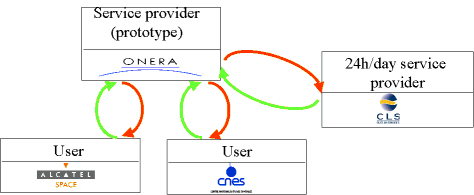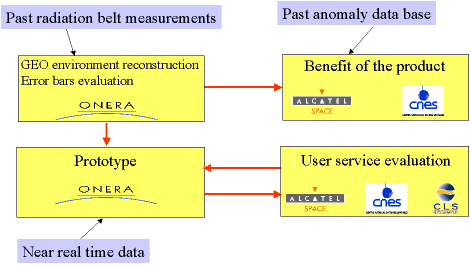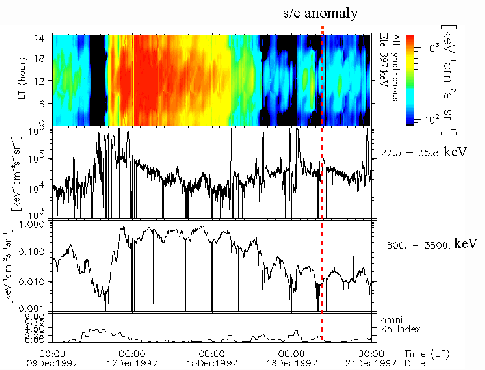| GSP Study Archive |
|---|
| Space Weather Studies |
| Applications Pilot Project |
| Feasibility Studies |
| CDF Space Weather Study |
| Past Workshops |
| Past Publications |
GEISHA
Geosynchronous Environment for Identification of Satellite Hit Anomalies
Developer
ONERA
Technical Group
Spacecraft & Aircraft
SDA objective
Space weather service for the analysis of anomalies on spacecraft after major events, the focus being the geosynchronous orbit.
Products
- Electron and proton fluxes int GEO
- Space Environment Effects (SEEs) analysis
- Solar arrays degradation analysis
- Surface and deep dielectric charging analysis
- Public service: Daily updated dynamic plots for electron and proton fluxes at 0 degres longitude at GEO
Link to Project WebSite
Study web site : http://wwwe.onecert.fr/geisha
SDA description
It has become evident that the space environment is a highly aggressive medium. Indeed, beyond the natural protection provided by the Earth's atmosphere, various types of radiation can be encountered. Their characteristics (energy and nature), their origins and their distributions in space are extremely variable (Figure 1). This environment degrades electronic systems and on-board equipment, induces noise on detectors and creates radiobiological hazards during manned flights. Although spacecraft are designed to survive to average level of the natural space environment, the consequences of geomagnetic storms in the radiation belts or solar particles events are more critical. The degradations and disturbances induced in materials and electronic components by radiation in space are phenomena that have been studied for many years. Two categories of effects should be noted:
- cumulative effects such as aging of thermal control coatings, optics and electronics, and erosion of materials;
- sporadic effects such as noise in detectors and optics, singular events in highly integrated electronic circuits and electrostatic discharges.
Figure 1 : GEO, a highly dynamic environment
All orbits crossing the Earth radiation belts are concerned by those effects. Anyway the priority is to be given to geosynchronous orbits because the majority of operational spacecraft (for TV, transmission, meteorology …) are located at this altitude and any progress in the understanding of the space environment at geosynchronous will therefore be of great benefit for spacecraft manufacturers and operators.
In the present study the consortium (Figure 2) will focus on prototyping a space weather service able to help in the analysis of anomalies that may appear on spacecraft after major events, the focus being geosynchronous orbit.
Figure 2 : Role for each entity in the consortium
US instruments are flying on geostationnary operational spacecraft (GOES and LANL/GEO series), and provide a large amount of useful data available on a real time or near real time basis. However, the data must be properly analysed and exploited and in that perspective (Figure 3), a fusion of such data with physical modelling shall provide a decisive way forward for satellite manufacturers and operators. Such a new approach will allow to extrapolate local in-situ measurement to all longitudes on the geosynchronous orbit (Figure 4), and by extension in the future, to propagate this boundary condition to all orbital altitudes below this geosynchronous orbit.
Figure 3 : Data exploitation and research plan
Figure 4 : Electron flux prediction at a given longitude (red line show the time of the spacecraft anomaly)
The main goals of this study are:
- Development of Interfaces with real time or near real time data providers;
- Data assimilation and modelling resource to prototype a space weather service;
- Integration of Satellite manufacturers and operators requirements and quantification of benefits from the service.
Consortium
- Office National d'Etude et de Recherche Aérospatiales (ONERA/DESP)
- Alcatel Space (ASP)
- Centre National d'Etude Spatiale (CNES)
- Collecte Localisation Satellites (CLS)
Contact / Manager
Dr. S. Bourdarie
| Address: | 2, Av.
Edouard Belin 31055 Toulouse Cedex 4 France |
| E-mail: | Sebastien.Bourdarie@onecert.fr |
| Telephone: | + 33 5 62 25 27 56 |





